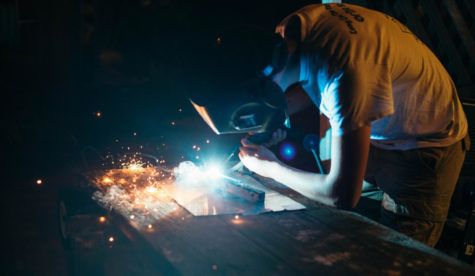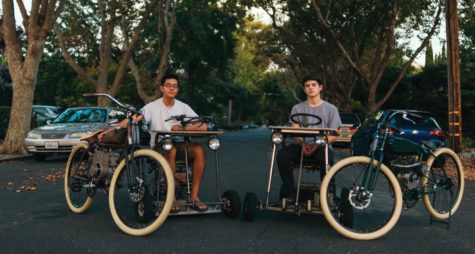A New Type of Street Art
5 MIN READCurious eyes widened and heads turned as surrounding students, startled and confused, watched two freshmen zoom past them on motorized desks, speeding off at 27 miles per hour. It was truly a sight to be seen. Nathan Kim and Peter Martin had been toiling away on their creations for months and it was finally time to unveil them to the rest of Paly. At 8 a.m. on the last day of school, Nathan Kim and Peter Martin raced out to their vehicles and took off.
Subjectively, art can be defined by each person’s individual experience. As art has travelled on a path from traditional to contemporary, it has created diverse movements and styles, and in our modernistic society, engineering has proven itself as an artistic outlet in a multitude of ways.

Art can also be considered the end product of a skillset, such as cooking or carpentry. “Engineering itself is not an art form,” Martin said. However, he does believe that it can be done in an artful way and that their go-karts exemplify that concept. “It’s the appearance that really makes it art,” Martin said.
They compare their creations to other, more alternative design formats, such as performance race cars or mid-century modern furniture. Reflecting upon this spin on more traditional art forms, Marin and Kim claim that this is the first time their creations have ever been acknowledged as art.
Kim and Martin’s engineering background is rooted in the skills and exposure they gained from their fathers. Martin’s dad worked on medical devices, so he had access to a shop in his garage from a young age. He was deeply influenced by his father’s work: “The idea of being technical with your hands got passed down to me,” Martin said.
Similarly, Kim says that his access to equipment and familiarity with designing products stemmed from learning engineering concepts from his father. “I have all the stuff you need to work with metal; it’s been like that ever since I was a kid,” Kim said. “I’ve gotten to know the tools fairly well. I was taught to use all of them by age 11.”
These paternal influences are what ultimately provided the two with the experience, tools and supervision necessary to create.
The pair have been close friends since eighth grade and have thrived off one another’s creative spirit, continually devoting hours of time and effort to their work. For years, Martin has been piecing together his garage into a fully functioning, small scale workshop that now includes a 3D printer and many other high level fabrication and metal tools. While both have dabbled in producing many other pieces of work, the journey from tinkering with small gadgets to constructing the famous go-kart desks all began in the Paly autoshop.

The young, eager and innovative freshmen were overwhelmed by the cavernous building in which Auto class is held, as it was filled with dusty cars and gleaming equipment. In that building, an imaginative vision was formed, and soon after, the concept for the iconic motorized desks began to take shape.
“We were sitting in the auto shop freshman year, excited to be in such a space, and we pretended to drive the desks like they were cars,” Martin said. “We then got the idea of making it a reality, and from coming up [with where] the parts would go and how much it would cost, we got some desks and started building.” The playful idea spurred the beginning of a 6 month adventure.
Their goal was to have created a fully functioning desk kart by the end of the year, allowing them to leave the last day of school in style, speeding towards summer. This sent them into a building frenzy, seeking out supplies, spending hours in Martin’s garage, and welding various metal parts at 2,000 degrees celsius, sparks flying. As the visual aesthetic and overall designs of the devices began to materialize, their approaches started to diverge. “One of the things that was kind of surprising to me was that at the beginning, I thought they’d be pretty similar, but we actually took different approaches to solving the same design issues,” Martin said.
Even while working together, their karts began to develop into separate beasts.
They spent every weekend testing, adjusting and retesting to try and fix every problem that would occur. By the time finals week rolled around, the karts were still not completed. Kim and Martin had a choice to make: karts or studying? Obviously, they chose their karts.
After a summer of racing around and testing the limits of their karts, they decided to enter them in the Maker’s Faire in San Mateo. They set up a booth, surrounded by craftsmen who had been perfecting their art and visual pieces for years. Visitors quickly began flocking to their table in hopes of a chance to ride the desk karts. Tip jars were set up, representing each kart respectively, every dollar and coin measuring the quality of their craftsmanship. The two later triumphantly headed home, the karts in the back of their truck, and Editor’s Choice award in hand.“It felt pretty good,” Martin said. “Not many people were getting those.”
This may have been the first time they made money off the karts, but it would certainly not be the last. Kim offers a lap around the quad on the desk kart for one dollar. When the pair were asked if they would ever sell their go-karts, Kim was open to the idea whereas Martin was not.

Despite the opportunity to make a profit on their designs, the two heavily discussed the many transactions that took place in order to obtain the necessary parts. The list of products grew longer, but they were able to purchase them from sites like EBay and Craigslist, or through a visit to Alan’s Steel Yard, located in Redwood City. “Batteries are really expensive, so the new battery pack cost me $350, but outside of that, it puts the total cost [of the kart] at $450,” Kim said of his total costs. The karts have proven to be profitable, and are essentially considered as significant investments of time and money.
As the two have grown into strong engineers with challenge-focused mindsets, their brilliant designs serve as an extension of their own technical imagination. Art is considered personally expressive, and just as a painter uses a paintbrush to convey their emotions and communicate a story to the viewer, Kim and Martin use welding and fabrication tools to express their creativity and their problem-solving skills. Not only is there an element of functionality in the karts, but also visual appeal plays a significant role in the way people see art, including Martin. “I see art as an extension of yourself,” Martin said. “These go-karts are an extension of ourselves, and they are very different, because Nathan and I are very different, so the process that each of us went through defines us.”








